Tax Assignment: Comparing Black Economy, Shared Economy, and Uber
VerifiedAdded on 2019/11/26
|13
|3568
|181
Report
AI Summary
This tax assignment report delves into the concepts of the black economy and the shared economy, analyzing their characteristics and implications. It examines the black economy as economic activities outside regulatory frameworks, including illegal and unaccounted legal activities. The report then explores the shared economy, where individuals share assets and services, contrasting it with traditional economic models. A significant portion of the report compares Uber Australia, a key player in the shared economy, with Cab Charge, which operates under a traditional business model. The analysis includes Uber's business practices, financial performance, and tax payments in comparison to Cab Charge, highlighting the differences in their operational frameworks and impacts on the economy. The report also discusses challenges faced by Uber, such as debt structure, and the criticisms faced by Cab Charge, particularly regarding its pricing strategies. The report provides a comprehensive overview of the two economic models, offering insights into their operations and effects on the business landscape, focusing on the Australian market.

Running head: TAX ASSIGNMENT
Tax Assignment
Name of the Student
Name of the University
Author Note
Tax Assignment
Name of the Student
Name of the University
Author Note
Paraphrase This Document
Need a fresh take? Get an instant paraphrase of this document with our AI Paraphraser
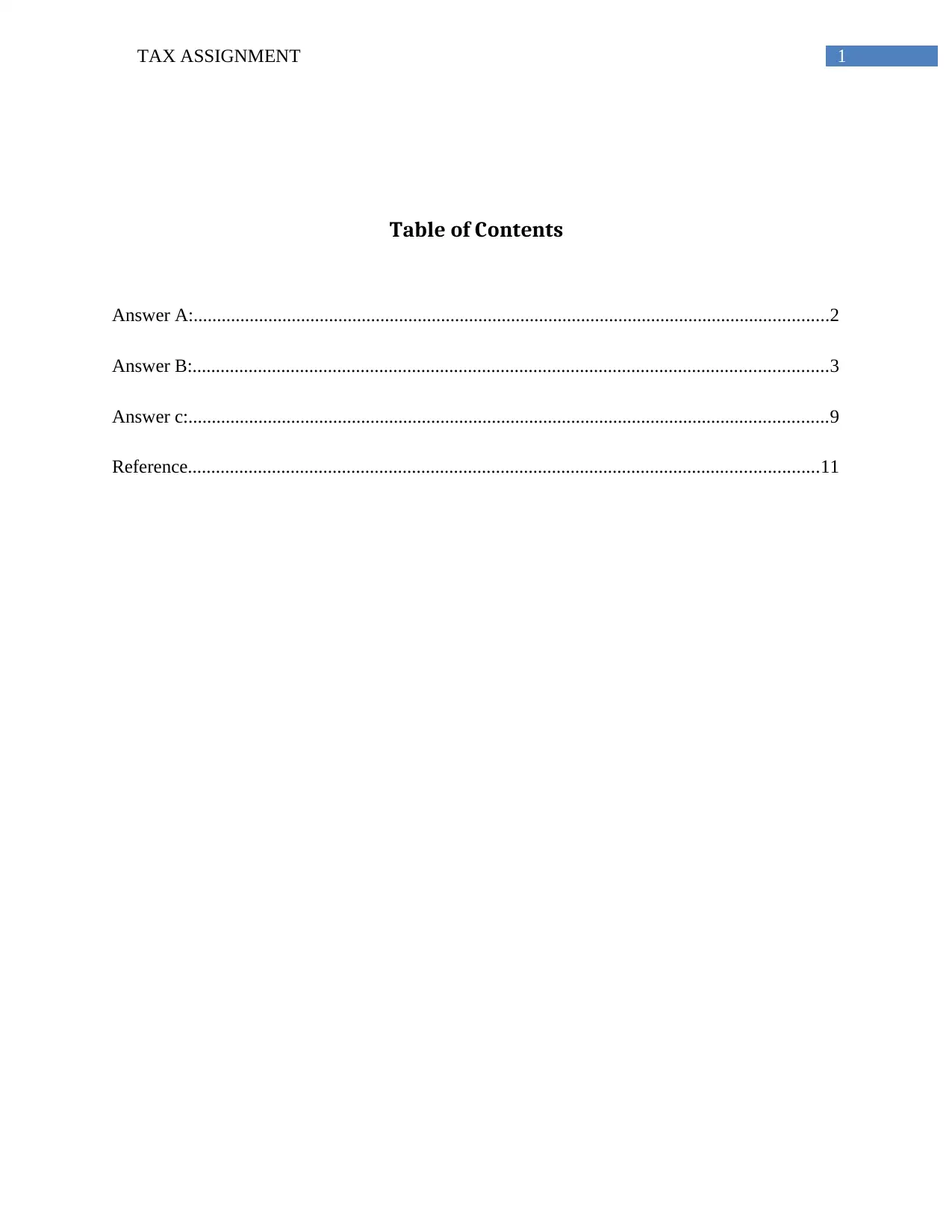
1TAX ASSIGNMENT
Table of Contents
Answer A:........................................................................................................................................2
Answer B:........................................................................................................................................3
Answer c:.........................................................................................................................................9
Reference.......................................................................................................................................11
Table of Contents
Answer A:........................................................................................................................................2
Answer B:........................................................................................................................................3
Answer c:.........................................................................................................................................9
Reference.......................................................................................................................................11
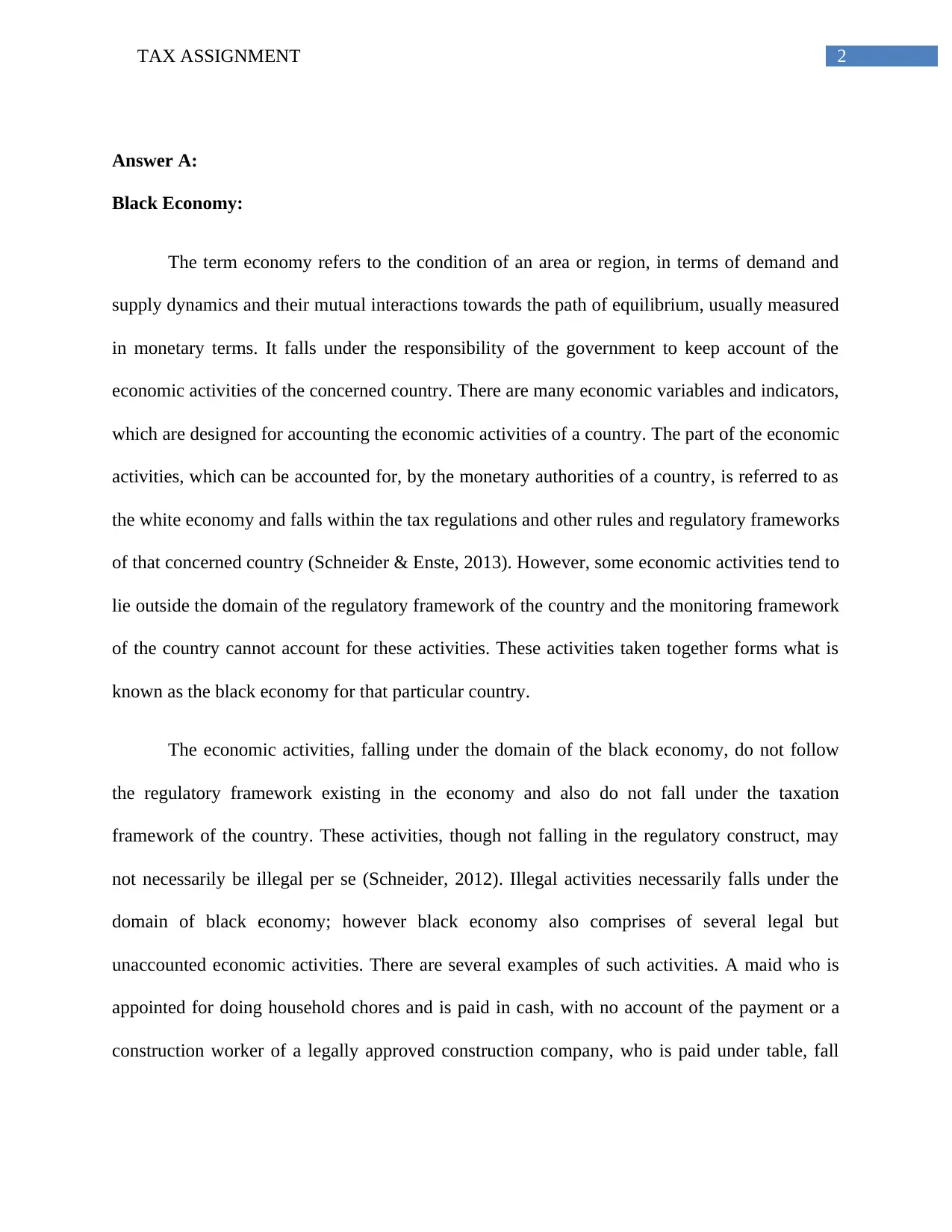
2TAX ASSIGNMENT
Answer A:
Black Economy:
The term economy refers to the condition of an area or region, in terms of demand and
supply dynamics and their mutual interactions towards the path of equilibrium, usually measured
in monetary terms. It falls under the responsibility of the government to keep account of the
economic activities of the concerned country. There are many economic variables and indicators,
which are designed for accounting the economic activities of a country. The part of the economic
activities, which can be accounted for, by the monetary authorities of a country, is referred to as
the white economy and falls within the tax regulations and other rules and regulatory frameworks
of that concerned country (Schneider & Enste, 2013). However, some economic activities tend to
lie outside the domain of the regulatory framework of the country and the monitoring framework
of the country cannot account for these activities. These activities taken together forms what is
known as the black economy for that particular country.
The economic activities, falling under the domain of the black economy, do not follow
the regulatory framework existing in the economy and also do not fall under the taxation
framework of the country. These activities, though not falling in the regulatory construct, may
not necessarily be illegal per se (Schneider, 2012). Illegal activities necessarily falls under the
domain of black economy; however black economy also comprises of several legal but
unaccounted economic activities. There are several examples of such activities. A maid who is
appointed for doing household chores and is paid in cash, with no account of the payment or a
construction worker of a legally approved construction company, who is paid under table, fall
Answer A:
Black Economy:
The term economy refers to the condition of an area or region, in terms of demand and
supply dynamics and their mutual interactions towards the path of equilibrium, usually measured
in monetary terms. It falls under the responsibility of the government to keep account of the
economic activities of the concerned country. There are many economic variables and indicators,
which are designed for accounting the economic activities of a country. The part of the economic
activities, which can be accounted for, by the monetary authorities of a country, is referred to as
the white economy and falls within the tax regulations and other rules and regulatory frameworks
of that concerned country (Schneider & Enste, 2013). However, some economic activities tend to
lie outside the domain of the regulatory framework of the country and the monitoring framework
of the country cannot account for these activities. These activities taken together forms what is
known as the black economy for that particular country.
The economic activities, falling under the domain of the black economy, do not follow
the regulatory framework existing in the economy and also do not fall under the taxation
framework of the country. These activities, though not falling in the regulatory construct, may
not necessarily be illegal per se (Schneider, 2012). Illegal activities necessarily falls under the
domain of black economy; however black economy also comprises of several legal but
unaccounted economic activities. There are several examples of such activities. A maid who is
appointed for doing household chores and is paid in cash, with no account of the payment or a
construction worker of a legally approved construction company, who is paid under table, fall
⊘ This is a preview!⊘
Do you want full access?
Subscribe today to unlock all pages.

Trusted by 1+ million students worldwide

3TAX ASSIGNMENT
under the purview if black economy. Again taking bribes, money earned through smuggling,
being illegal economic activities, also fall in this domain (Beckert & Wehinger, 2012).
Shared Economy:
A special form of economy, which can prevail in real case scenario, is a shared economy.
In this type of economic structure, individuals can borrow commodities and services, which are
owned by some other individual. This implies that in a shared economy, the assets, including
goods as well as services can be privately shared between the individuals living in the country.
This type of economy has been in existence from the advent of the concept of society in
humankind. The ways of operation of this type of economy has changed substantially but the
underlying concept has remained the same (Böckmann, 2013). The main objective of this
economic framework is to maximize the welfare of the society as a whole, by enriching the lives
of the residents of the concerned economy. The basic intuition behind this economic concept is
that some other individual, who is deprived and is in need of that particular asset can, more
efficiently use the under-utilized assets lying with an individual. In the current age, with
significant innovations in technology, communications have been hugely facilitated, thereby
making the sharing activities more easy ad hugely widespread, thereby facilitating the existence
of the shared economic framework (Cohen & Kietzmann, 2014).
Answer B:
This part of the assignment tries to discuss the different aspects of the sharing economic
model and tries to compare these aspects with that of the traditional economic models to analyze
the influence of these aspects on the overall business conditions of the economy and the mode of
under the purview if black economy. Again taking bribes, money earned through smuggling,
being illegal economic activities, also fall in this domain (Beckert & Wehinger, 2012).
Shared Economy:
A special form of economy, which can prevail in real case scenario, is a shared economy.
In this type of economic structure, individuals can borrow commodities and services, which are
owned by some other individual. This implies that in a shared economy, the assets, including
goods as well as services can be privately shared between the individuals living in the country.
This type of economy has been in existence from the advent of the concept of society in
humankind. The ways of operation of this type of economy has changed substantially but the
underlying concept has remained the same (Böckmann, 2013). The main objective of this
economic framework is to maximize the welfare of the society as a whole, by enriching the lives
of the residents of the concerned economy. The basic intuition behind this economic concept is
that some other individual, who is deprived and is in need of that particular asset can, more
efficiently use the under-utilized assets lying with an individual. In the current age, with
significant innovations in technology, communications have been hugely facilitated, thereby
making the sharing activities more easy ad hugely widespread, thereby facilitating the existence
of the shared economic framework (Cohen & Kietzmann, 2014).
Answer B:
This part of the assignment tries to discuss the different aspects of the sharing economic
model and tries to compare these aspects with that of the traditional economic models to analyze
the influence of these aspects on the overall business conditions of the economy and the mode of
Paraphrase This Document
Need a fresh take? Get an instant paraphrase of this document with our AI Paraphraser

4TAX ASSIGNMENT
operation of the business enterprises existing under the concerned economic models. In a sharing
economy model, as discussed earlier, the individuals are allowed to privately share the goods and
services, already owned by some individuals, in lieu of some monetary exchange or also for free,
depending upon the situation and the nature of the goods or services availed. On the other hand,
the traditional economic models do not have such provisions of sharing of services. In these type
of markets, goods or services, once bought by someone, becomes eligible to be used by the
owner himself and by no one else (Matzler, Veider & Kathan, 2015). To understand the
differences between the characteristic of these two economy and business model types, two
organizations, Uber Australia and that of the Cab charge Australia are considered with the
country of observation taken to be Australia.
With innovations in the communication and overall technology, sharing economic model
is coming into existence, even stronger than before. One such industry, working in the business
model of sharing economy is that of point to point transport industry, which mainly consists of
the cab service companies, Uber being one of the most significant players in this industry. The
industry as a whole and Uber being a part of it, provides their customers the convenience of
travelling to and from their preferred destinations at their time of convenience (Cramer &
Krueger, 2016).
Uber Australia, one of the biggest cab facilities, works towards providing their clients the
above-mentioned facilities in exchange of fares, as designed by the company. The customers can
book the cabs instantly and they can be pre-booked. With the new age technologies and
predominant usage of internet, cabs of Uber can be booked with the help of the online
applications, easily installable in mobile phones, thereby making the process immensely easy and
mobile (Allen, 2015). The mode of operation of Uber Australia, has relevance with that of the
operation of the business enterprises existing under the concerned economic models. In a sharing
economy model, as discussed earlier, the individuals are allowed to privately share the goods and
services, already owned by some individuals, in lieu of some monetary exchange or also for free,
depending upon the situation and the nature of the goods or services availed. On the other hand,
the traditional economic models do not have such provisions of sharing of services. In these type
of markets, goods or services, once bought by someone, becomes eligible to be used by the
owner himself and by no one else (Matzler, Veider & Kathan, 2015). To understand the
differences between the characteristic of these two economy and business model types, two
organizations, Uber Australia and that of the Cab charge Australia are considered with the
country of observation taken to be Australia.
With innovations in the communication and overall technology, sharing economic model
is coming into existence, even stronger than before. One such industry, working in the business
model of sharing economy is that of point to point transport industry, which mainly consists of
the cab service companies, Uber being one of the most significant players in this industry. The
industry as a whole and Uber being a part of it, provides their customers the convenience of
travelling to and from their preferred destinations at their time of convenience (Cramer &
Krueger, 2016).
Uber Australia, one of the biggest cab facilities, works towards providing their clients the
above-mentioned facilities in exchange of fares, as designed by the company. The customers can
book the cabs instantly and they can be pre-booked. With the new age technologies and
predominant usage of internet, cabs of Uber can be booked with the help of the online
applications, easily installable in mobile phones, thereby making the process immensely easy and
mobile (Allen, 2015). The mode of operation of Uber Australia, has relevance with that of the
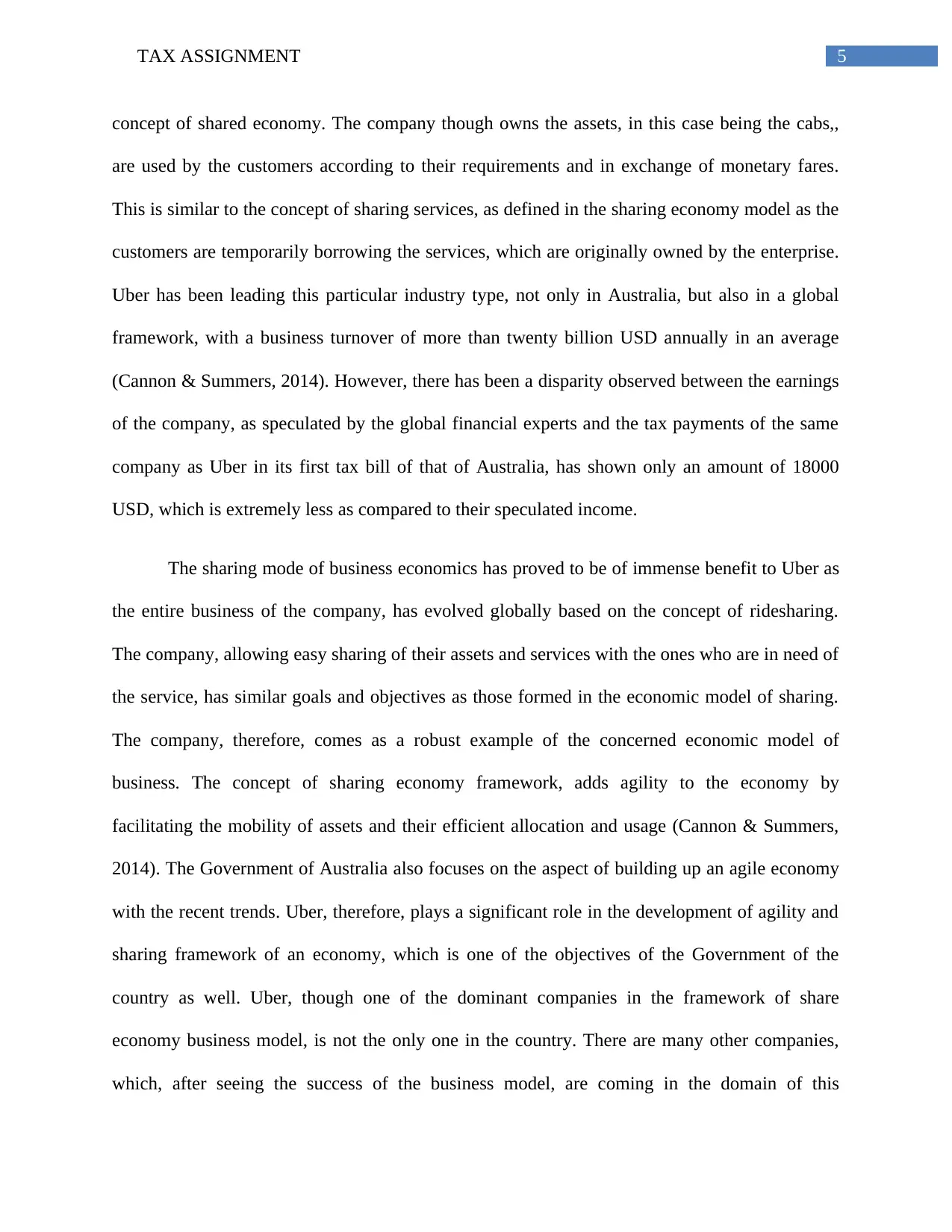
5TAX ASSIGNMENT
concept of shared economy. The company though owns the assets, in this case being the cabs,,
are used by the customers according to their requirements and in exchange of monetary fares.
This is similar to the concept of sharing services, as defined in the sharing economy model as the
customers are temporarily borrowing the services, which are originally owned by the enterprise.
Uber has been leading this particular industry type, not only in Australia, but also in a global
framework, with a business turnover of more than twenty billion USD annually in an average
(Cannon & Summers, 2014). However, there has been a disparity observed between the earnings
of the company, as speculated by the global financial experts and the tax payments of the same
company as Uber in its first tax bill of that of Australia, has shown only an amount of 18000
USD, which is extremely less as compared to their speculated income.
The sharing mode of business economics has proved to be of immense benefit to Uber as
the entire business of the company, has evolved globally based on the concept of ridesharing.
The company, allowing easy sharing of their assets and services with the ones who are in need of
the service, has similar goals and objectives as those formed in the economic model of sharing.
The company, therefore, comes as a robust example of the concerned economic model of
business. The concept of sharing economy framework, adds agility to the economy by
facilitating the mobility of assets and their efficient allocation and usage (Cannon & Summers,
2014). The Government of Australia also focuses on the aspect of building up an agile economy
with the recent trends. Uber, therefore, plays a significant role in the development of agility and
sharing framework of an economy, which is one of the objectives of the Government of the
country as well. Uber, though one of the dominant companies in the framework of share
economy business model, is not the only one in the country. There are many other companies,
which, after seeing the success of the business model, are coming in the domain of this
concept of shared economy. The company though owns the assets, in this case being the cabs,,
are used by the customers according to their requirements and in exchange of monetary fares.
This is similar to the concept of sharing services, as defined in the sharing economy model as the
customers are temporarily borrowing the services, which are originally owned by the enterprise.
Uber has been leading this particular industry type, not only in Australia, but also in a global
framework, with a business turnover of more than twenty billion USD annually in an average
(Cannon & Summers, 2014). However, there has been a disparity observed between the earnings
of the company, as speculated by the global financial experts and the tax payments of the same
company as Uber in its first tax bill of that of Australia, has shown only an amount of 18000
USD, which is extremely less as compared to their speculated income.
The sharing mode of business economics has proved to be of immense benefit to Uber as
the entire business of the company, has evolved globally based on the concept of ridesharing.
The company, allowing easy sharing of their assets and services with the ones who are in need of
the service, has similar goals and objectives as those formed in the economic model of sharing.
The company, therefore, comes as a robust example of the concerned economic model of
business. The concept of sharing economy framework, adds agility to the economy by
facilitating the mobility of assets and their efficient allocation and usage (Cannon & Summers,
2014). The Government of Australia also focuses on the aspect of building up an agile economy
with the recent trends. Uber, therefore, plays a significant role in the development of agility and
sharing framework of an economy, which is one of the objectives of the Government of the
country as well. Uber, though one of the dominant companies in the framework of share
economy business model, is not the only one in the country. There are many other companies,
which, after seeing the success of the business model, are coming in the domain of this
⊘ This is a preview!⊘
Do you want full access?
Subscribe today to unlock all pages.

Trusted by 1+ million students worldwide
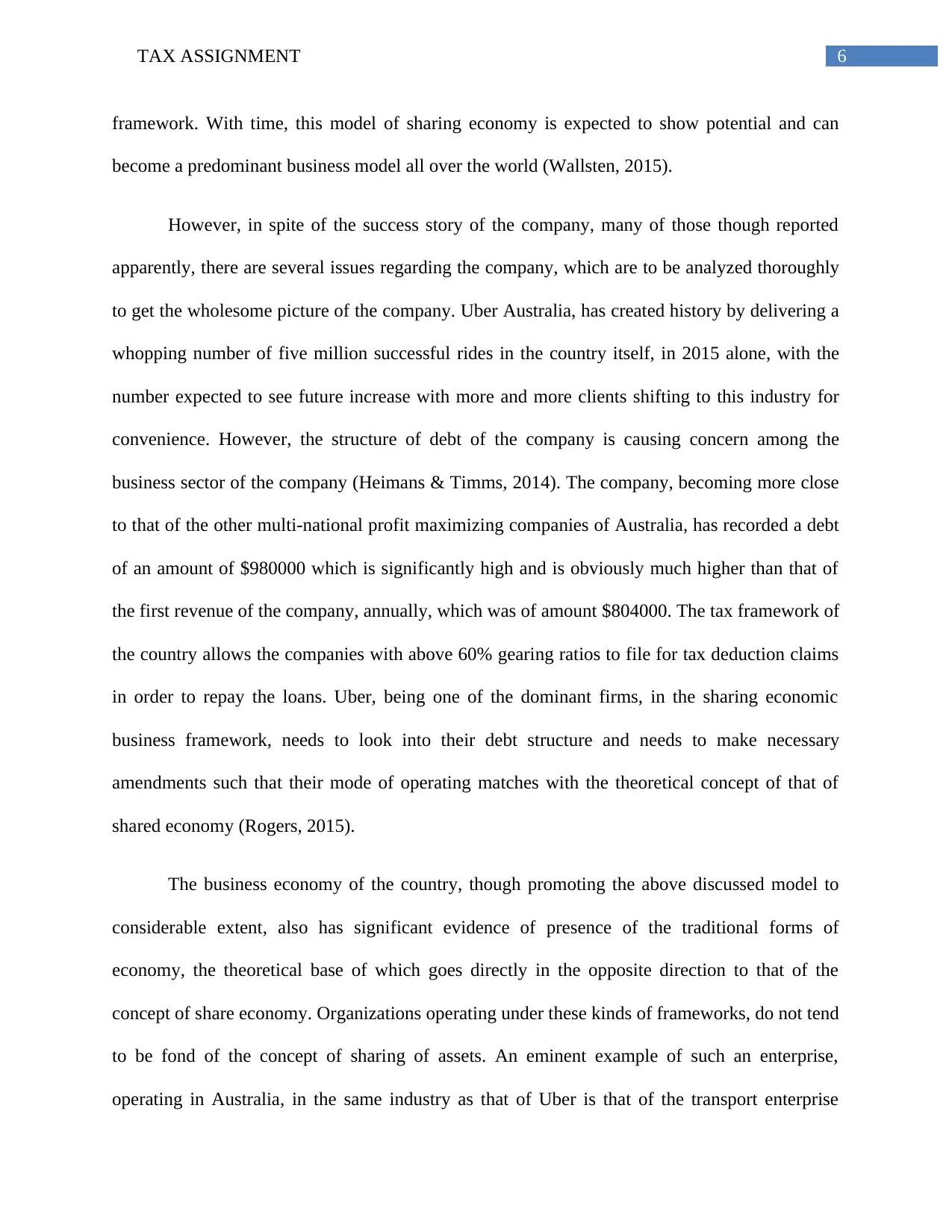
6TAX ASSIGNMENT
framework. With time, this model of sharing economy is expected to show potential and can
become a predominant business model all over the world (Wallsten, 2015).
However, in spite of the success story of the company, many of those though reported
apparently, there are several issues regarding the company, which are to be analyzed thoroughly
to get the wholesome picture of the company. Uber Australia, has created history by delivering a
whopping number of five million successful rides in the country itself, in 2015 alone, with the
number expected to see future increase with more and more clients shifting to this industry for
convenience. However, the structure of debt of the company is causing concern among the
business sector of the company (Heimans & Timms, 2014). The company, becoming more close
to that of the other multi-national profit maximizing companies of Australia, has recorded a debt
of an amount of $980000 which is significantly high and is obviously much higher than that of
the first revenue of the company, annually, which was of amount $804000. The tax framework of
the country allows the companies with above 60% gearing ratios to file for tax deduction claims
in order to repay the loans. Uber, being one of the dominant firms, in the sharing economic
business framework, needs to look into their debt structure and needs to make necessary
amendments such that their mode of operating matches with the theoretical concept of that of
shared economy (Rogers, 2015).
The business economy of the country, though promoting the above discussed model to
considerable extent, also has significant evidence of presence of the traditional forms of
economy, the theoretical base of which goes directly in the opposite direction to that of the
concept of share economy. Organizations operating under these kinds of frameworks, do not tend
to be fond of the concept of sharing of assets. An eminent example of such an enterprise,
operating in Australia, in the same industry as that of Uber is that of the transport enterprise
framework. With time, this model of sharing economy is expected to show potential and can
become a predominant business model all over the world (Wallsten, 2015).
However, in spite of the success story of the company, many of those though reported
apparently, there are several issues regarding the company, which are to be analyzed thoroughly
to get the wholesome picture of the company. Uber Australia, has created history by delivering a
whopping number of five million successful rides in the country itself, in 2015 alone, with the
number expected to see future increase with more and more clients shifting to this industry for
convenience. However, the structure of debt of the company is causing concern among the
business sector of the company (Heimans & Timms, 2014). The company, becoming more close
to that of the other multi-national profit maximizing companies of Australia, has recorded a debt
of an amount of $980000 which is significantly high and is obviously much higher than that of
the first revenue of the company, annually, which was of amount $804000. The tax framework of
the country allows the companies with above 60% gearing ratios to file for tax deduction claims
in order to repay the loans. Uber, being one of the dominant firms, in the sharing economic
business framework, needs to look into their debt structure and needs to make necessary
amendments such that their mode of operating matches with the theoretical concept of that of
shared economy (Rogers, 2015).
The business economy of the country, though promoting the above discussed model to
considerable extent, also has significant evidence of presence of the traditional forms of
economy, the theoretical base of which goes directly in the opposite direction to that of the
concept of share economy. Organizations operating under these kinds of frameworks, do not tend
to be fond of the concept of sharing of assets. An eminent example of such an enterprise,
operating in Australia, in the same industry as that of Uber is that of the transport enterprise
Paraphrase This Document
Need a fresh take? Get an instant paraphrase of this document with our AI Paraphraser
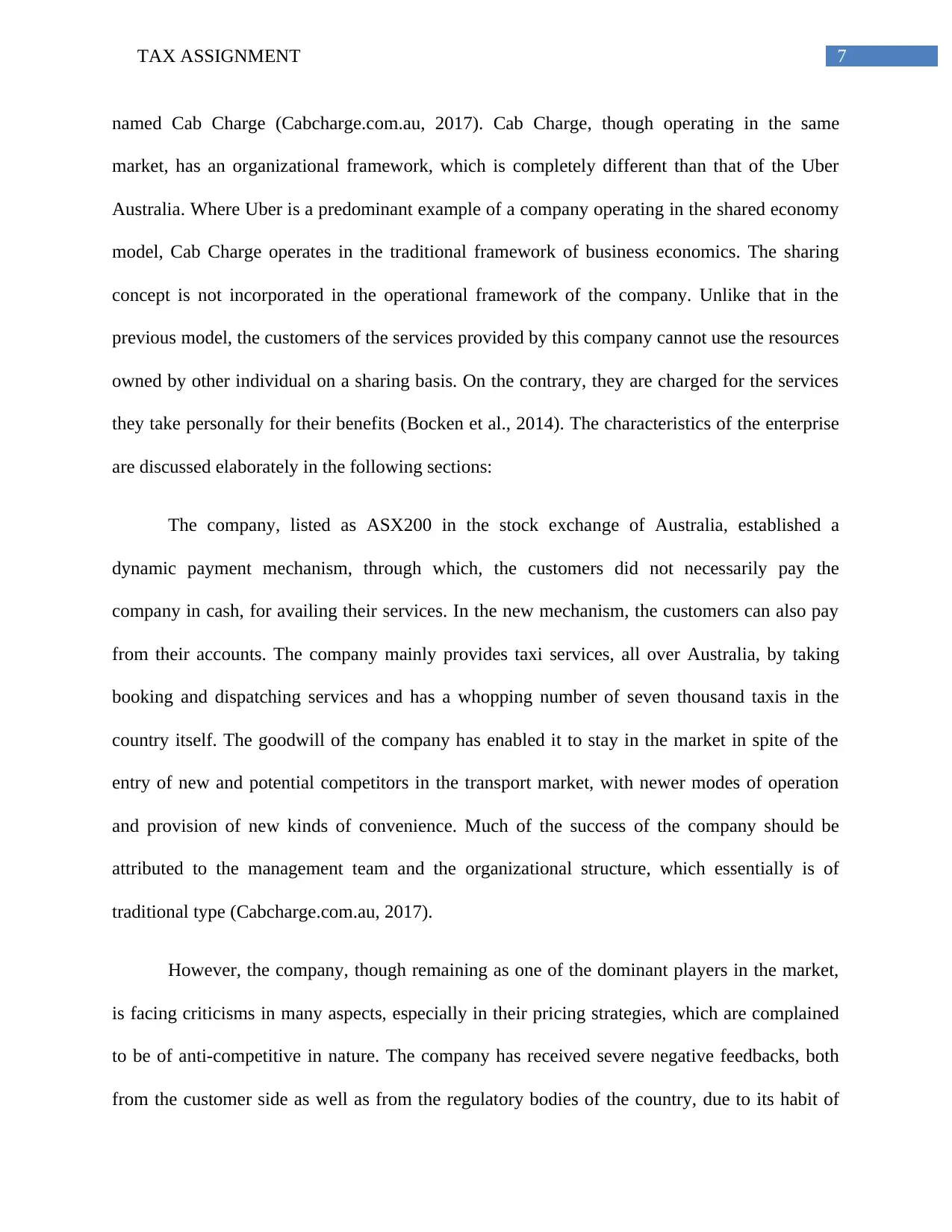
7TAX ASSIGNMENT
named Cab Charge (Cabcharge.com.au, 2017). Cab Charge, though operating in the same
market, has an organizational framework, which is completely different than that of the Uber
Australia. Where Uber is a predominant example of a company operating in the shared economy
model, Cab Charge operates in the traditional framework of business economics. The sharing
concept is not incorporated in the operational framework of the company. Unlike that in the
previous model, the customers of the services provided by this company cannot use the resources
owned by other individual on a sharing basis. On the contrary, they are charged for the services
they take personally for their benefits (Bocken et al., 2014). The characteristics of the enterprise
are discussed elaborately in the following sections:
The company, listed as ASX200 in the stock exchange of Australia, established a
dynamic payment mechanism, through which, the customers did not necessarily pay the
company in cash, for availing their services. In the new mechanism, the customers can also pay
from their accounts. The company mainly provides taxi services, all over Australia, by taking
booking and dispatching services and has a whopping number of seven thousand taxis in the
country itself. The goodwill of the company has enabled it to stay in the market in spite of the
entry of new and potential competitors in the transport market, with newer modes of operation
and provision of new kinds of convenience. Much of the success of the company should be
attributed to the management team and the organizational structure, which essentially is of
traditional type (Cabcharge.com.au, 2017).
However, the company, though remaining as one of the dominant players in the market,
is facing criticisms in many aspects, especially in their pricing strategies, which are complained
to be of anti-competitive in nature. The company has received severe negative feedbacks, both
from the customer side as well as from the regulatory bodies of the country, due to its habit of
named Cab Charge (Cabcharge.com.au, 2017). Cab Charge, though operating in the same
market, has an organizational framework, which is completely different than that of the Uber
Australia. Where Uber is a predominant example of a company operating in the shared economy
model, Cab Charge operates in the traditional framework of business economics. The sharing
concept is not incorporated in the operational framework of the company. Unlike that in the
previous model, the customers of the services provided by this company cannot use the resources
owned by other individual on a sharing basis. On the contrary, they are charged for the services
they take personally for their benefits (Bocken et al., 2014). The characteristics of the enterprise
are discussed elaborately in the following sections:
The company, listed as ASX200 in the stock exchange of Australia, established a
dynamic payment mechanism, through which, the customers did not necessarily pay the
company in cash, for availing their services. In the new mechanism, the customers can also pay
from their accounts. The company mainly provides taxi services, all over Australia, by taking
booking and dispatching services and has a whopping number of seven thousand taxis in the
country itself. The goodwill of the company has enabled it to stay in the market in spite of the
entry of new and potential competitors in the transport market, with newer modes of operation
and provision of new kinds of convenience. Much of the success of the company should be
attributed to the management team and the organizational structure, which essentially is of
traditional type (Cabcharge.com.au, 2017).
However, the company, though remaining as one of the dominant players in the market,
is facing criticisms in many aspects, especially in their pricing strategies, which are complained
to be of anti-competitive in nature. The company has received severe negative feedbacks, both
from the customer side as well as from the regulatory bodies of the country, due to its habit of
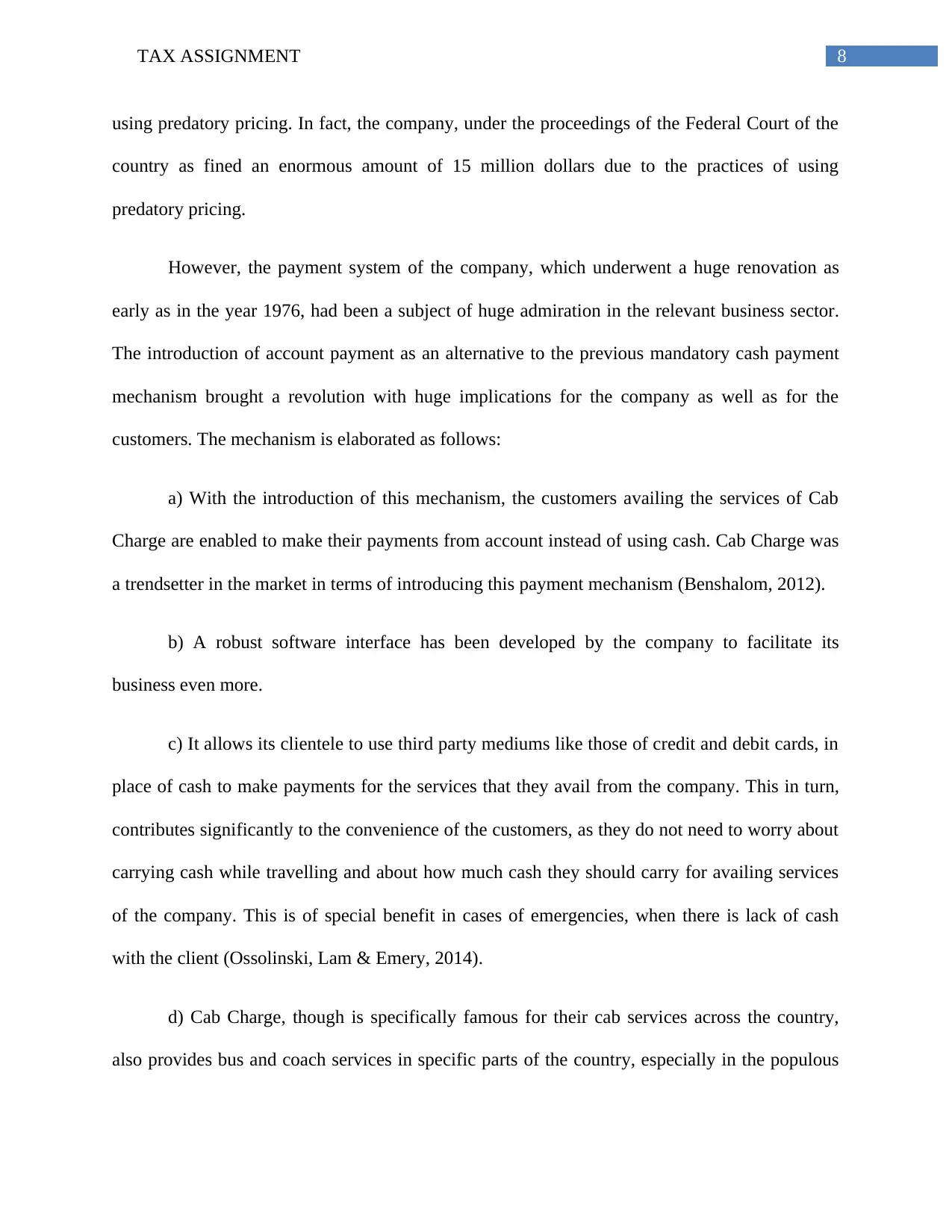
8TAX ASSIGNMENT
using predatory pricing. In fact, the company, under the proceedings of the Federal Court of the
country as fined an enormous amount of 15 million dollars due to the practices of using
predatory pricing.
However, the payment system of the company, which underwent a huge renovation as
early as in the year 1976, had been a subject of huge admiration in the relevant business sector.
The introduction of account payment as an alternative to the previous mandatory cash payment
mechanism brought a revolution with huge implications for the company as well as for the
customers. The mechanism is elaborated as follows:
a) With the introduction of this mechanism, the customers availing the services of Cab
Charge are enabled to make their payments from account instead of using cash. Cab Charge was
a trendsetter in the market in terms of introducing this payment mechanism (Benshalom, 2012).
b) A robust software interface has been developed by the company to facilitate its
business even more.
c) It allows its clientele to use third party mediums like those of credit and debit cards, in
place of cash to make payments for the services that they avail from the company. This in turn,
contributes significantly to the convenience of the customers, as they do not need to worry about
carrying cash while travelling and about how much cash they should carry for availing services
of the company. This is of special benefit in cases of emergencies, when there is lack of cash
with the client (Ossolinski, Lam & Emery, 2014).
d) Cab Charge, though is specifically famous for their cab services across the country,
also provides bus and coach services in specific parts of the country, especially in the populous
using predatory pricing. In fact, the company, under the proceedings of the Federal Court of the
country as fined an enormous amount of 15 million dollars due to the practices of using
predatory pricing.
However, the payment system of the company, which underwent a huge renovation as
early as in the year 1976, had been a subject of huge admiration in the relevant business sector.
The introduction of account payment as an alternative to the previous mandatory cash payment
mechanism brought a revolution with huge implications for the company as well as for the
customers. The mechanism is elaborated as follows:
a) With the introduction of this mechanism, the customers availing the services of Cab
Charge are enabled to make their payments from account instead of using cash. Cab Charge was
a trendsetter in the market in terms of introducing this payment mechanism (Benshalom, 2012).
b) A robust software interface has been developed by the company to facilitate its
business even more.
c) It allows its clientele to use third party mediums like those of credit and debit cards, in
place of cash to make payments for the services that they avail from the company. This in turn,
contributes significantly to the convenience of the customers, as they do not need to worry about
carrying cash while travelling and about how much cash they should carry for availing services
of the company. This is of special benefit in cases of emergencies, when there is lack of cash
with the client (Ossolinski, Lam & Emery, 2014).
d) Cab Charge, though is specifically famous for their cab services across the country,
also provides bus and coach services in specific parts of the country, especially in the populous
⊘ This is a preview!⊘
Do you want full access?
Subscribe today to unlock all pages.

Trusted by 1+ million students worldwide

9TAX ASSIGNMENT
and economic zones, namely State of Victoria and that of South Wales, the business being of
partnership in nature.
It is evident from the above discussion that the organizational framework of the company
is highly traditional in nature with the objective of personal profit maximization. The traditional
economic model has been of great benefit for the company, as can seen from their economic
performance and enjoyment of significant market share in the country over the years, despite the
entry of new firms with substantial potential. In spite of being tangled in several court
proceedings and fines, the turnover of the company has remained significantly high over the
years and saw even more increase with the introduction of non-cash mode of payment (Schor,
2016).
From the above discussion, it is evident that both the market structures, the traditional as
well as that of the shared economy business models have their pros and cons and on the basis of
the companies and their organizational structures, these models can prove to be beneficial for the
companies.
Answer c:
The Treasury in the Interim Report of the Taskforce for Black Economy has made several
recommendations in a generalized framework for the welfare of the overall economy. This
section of the assignment tries to analyze the recommendations, which specifically have
potentials to reduce the problems of black economy due to the shared economy model
(Consult.treasury.gov.au, 2017). These are discussed as follows:
and economic zones, namely State of Victoria and that of South Wales, the business being of
partnership in nature.
It is evident from the above discussion that the organizational framework of the company
is highly traditional in nature with the objective of personal profit maximization. The traditional
economic model has been of great benefit for the company, as can seen from their economic
performance and enjoyment of significant market share in the country over the years, despite the
entry of new firms with substantial potential. In spite of being tangled in several court
proceedings and fines, the turnover of the company has remained significantly high over the
years and saw even more increase with the introduction of non-cash mode of payment (Schor,
2016).
From the above discussion, it is evident that both the market structures, the traditional as
well as that of the shared economy business models have their pros and cons and on the basis of
the companies and their organizational structures, these models can prove to be beneficial for the
companies.
Answer c:
The Treasury in the Interim Report of the Taskforce for Black Economy has made several
recommendations in a generalized framework for the welfare of the overall economy. This
section of the assignment tries to analyze the recommendations, which specifically have
potentials to reduce the problems of black economy due to the shared economy model
(Consult.treasury.gov.au, 2017). These are discussed as follows:
Paraphrase This Document
Need a fresh take? Get an instant paraphrase of this document with our AI Paraphraser
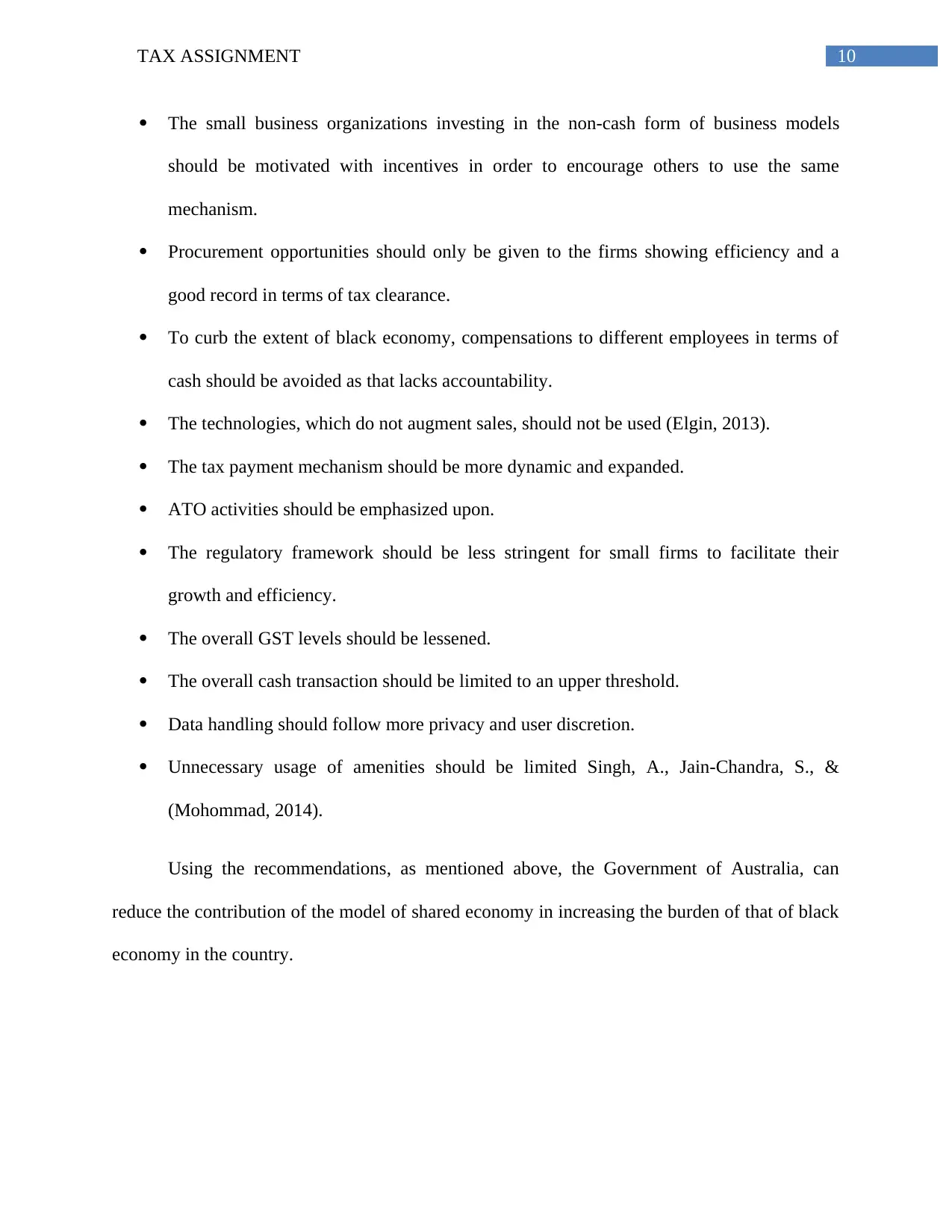
10TAX ASSIGNMENT
The small business organizations investing in the non-cash form of business models
should be motivated with incentives in order to encourage others to use the same
mechanism.
Procurement opportunities should only be given to the firms showing efficiency and a
good record in terms of tax clearance.
To curb the extent of black economy, compensations to different employees in terms of
cash should be avoided as that lacks accountability.
The technologies, which do not augment sales, should not be used (Elgin, 2013).
The tax payment mechanism should be more dynamic and expanded.
ATO activities should be emphasized upon.
The regulatory framework should be less stringent for small firms to facilitate their
growth and efficiency.
The overall GST levels should be lessened.
The overall cash transaction should be limited to an upper threshold.
Data handling should follow more privacy and user discretion.
Unnecessary usage of amenities should be limited Singh, A., Jain-Chandra, S., &
(Mohommad, 2014).
Using the recommendations, as mentioned above, the Government of Australia, can
reduce the contribution of the model of shared economy in increasing the burden of that of black
economy in the country.
The small business organizations investing in the non-cash form of business models
should be motivated with incentives in order to encourage others to use the same
mechanism.
Procurement opportunities should only be given to the firms showing efficiency and a
good record in terms of tax clearance.
To curb the extent of black economy, compensations to different employees in terms of
cash should be avoided as that lacks accountability.
The technologies, which do not augment sales, should not be used (Elgin, 2013).
The tax payment mechanism should be more dynamic and expanded.
ATO activities should be emphasized upon.
The regulatory framework should be less stringent for small firms to facilitate their
growth and efficiency.
The overall GST levels should be lessened.
The overall cash transaction should be limited to an upper threshold.
Data handling should follow more privacy and user discretion.
Unnecessary usage of amenities should be limited Singh, A., Jain-Chandra, S., &
(Mohommad, 2014).
Using the recommendations, as mentioned above, the Government of Australia, can
reduce the contribution of the model of shared economy in increasing the burden of that of black
economy in the country.
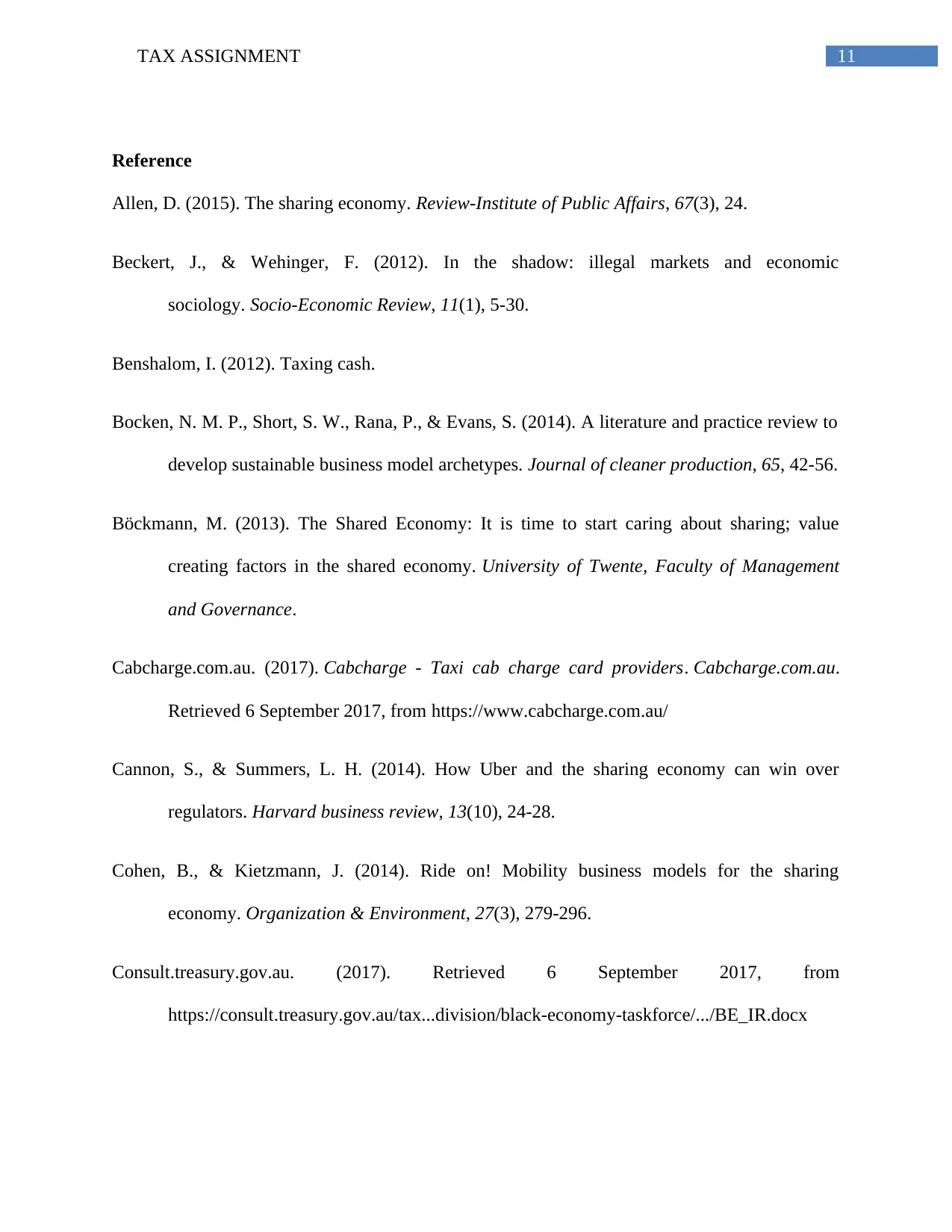
11TAX ASSIGNMENT
Reference
Allen, D. (2015). The sharing economy. Review-Institute of Public Affairs, 67(3), 24.
Beckert, J., & Wehinger, F. (2012). In the shadow: illegal markets and economic
sociology. Socio-Economic Review, 11(1), 5-30.
Benshalom, I. (2012). Taxing cash.
Bocken, N. M. P., Short, S. W., Rana, P., & Evans, S. (2014). A literature and practice review to
develop sustainable business model archetypes. Journal of cleaner production, 65, 42-56.
Böckmann, M. (2013). The Shared Economy: It is time to start caring about sharing; value
creating factors in the shared economy. University of Twente, Faculty of Management
and Governance.
Cabcharge.com.au. (2017). Cabcharge - Taxi cab charge card providers. Cabcharge.com.au.
Retrieved 6 September 2017, from https://www.cabcharge.com.au/
Cannon, S., & Summers, L. H. (2014). How Uber and the sharing economy can win over
regulators. Harvard business review, 13(10), 24-28.
Cohen, B., & Kietzmann, J. (2014). Ride on! Mobility business models for the sharing
economy. Organization & Environment, 27(3), 279-296.
Consult.treasury.gov.au. (2017). Retrieved 6 September 2017, from
https://consult.treasury.gov.au/tax...division/black-economy-taskforce/.../BE_IR.docx
Reference
Allen, D. (2015). The sharing economy. Review-Institute of Public Affairs, 67(3), 24.
Beckert, J., & Wehinger, F. (2012). In the shadow: illegal markets and economic
sociology. Socio-Economic Review, 11(1), 5-30.
Benshalom, I. (2012). Taxing cash.
Bocken, N. M. P., Short, S. W., Rana, P., & Evans, S. (2014). A literature and practice review to
develop sustainable business model archetypes. Journal of cleaner production, 65, 42-56.
Böckmann, M. (2013). The Shared Economy: It is time to start caring about sharing; value
creating factors in the shared economy. University of Twente, Faculty of Management
and Governance.
Cabcharge.com.au. (2017). Cabcharge - Taxi cab charge card providers. Cabcharge.com.au.
Retrieved 6 September 2017, from https://www.cabcharge.com.au/
Cannon, S., & Summers, L. H. (2014). How Uber and the sharing economy can win over
regulators. Harvard business review, 13(10), 24-28.
Cohen, B., & Kietzmann, J. (2014). Ride on! Mobility business models for the sharing
economy. Organization & Environment, 27(3), 279-296.
Consult.treasury.gov.au. (2017). Retrieved 6 September 2017, from
https://consult.treasury.gov.au/tax...division/black-economy-taskforce/.../BE_IR.docx
⊘ This is a preview!⊘
Do you want full access?
Subscribe today to unlock all pages.

Trusted by 1+ million students worldwide
1 out of 13
Related Documents
Your All-in-One AI-Powered Toolkit for Academic Success.
+13062052269
info@desklib.com
Available 24*7 on WhatsApp / Email
![[object Object]](/_next/static/media/star-bottom.7253800d.svg)
Unlock your academic potential
Copyright © 2020–2025 A2Z Services. All Rights Reserved. Developed and managed by ZUCOL.





